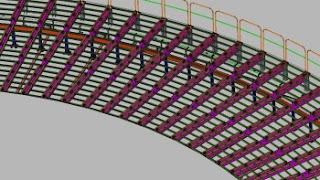Mitchell
Machine Works is in the business of building complex machines. Hailing from
Dalton, Ga., the company has been known the world over for its Magic Carpet, a
hydraulically driven roller system that can roll up, or roll out, an entire
sports field of turf in a matter of minutes.
Mitchell
Machine Works was founded in 1967 by the company’s self-described “chief
engineer, owner and just about everything else,” Mark Mitchell, who has gained
a reputation for being someone who can design and deliver complex machines.
Because of this pedigree and his previous experience building the Magic Carpet,
Mitchell picked up the phone one day and found himself with some surprise
business. On the other end of the line was a company that needed Mitchell to
build an indoor running track.
Taken
at face value, building an indoor running track doesn’t seem all that
mechanically complex. A track’s essentially an oval. A flat oval.
But
there was a catch.
Instead
of being flat, the indoor running track that Mitchell was being asked to build
had to be hydraulically driven, because, you see, some indoor track events use
a banked surface, not a flat one like its outdoor counterpart.
As
you can imagine, building a banking hydraulic indoor running track isn’t a
straightforward endeavor. In fact, building such a machine requires some
200,000 pounds of steel and 72,000 components (including 72 hydraulic
actuators)—and that doesn’t even take into account the 7,000 work hours
required to build the machine. What’s more, for an indoor track to work
properly, it has to work in perfect harmony, with each of the hydraulic drivers
that lift the track’s banks working in unison with its nearby neighbors.
As
Mitchell described it, one of the biggest issues facing the design of this
track was figuring out the complex control system that would be used to govern
how each hydraulic actuator worked, because as Mitchell noted, “given the
torsion in the system, no cylinder could be more than 10 mm out of line with
its neighbor.” To transform this seemingly intractable problem into something
more manageable, Mitchell looked to IronCAD.
Mitchell's Hydraulic
Track in IronCAD
Although
Mitchell is familiar with CAD, he turned much of the actual CAD work over to RJ
Saucier of Genesis Technology Systems. Working in concert with Saucier,
Mitchell was able to create a robust CAD model using IronCAD that gave him
great insight into how the hydraulic system worked.
Once
Mitchell’s vision for his indoor track had been modeled, Saucier and his team
set out to analyze how the track’s movement would affect its overall
performance. Using IronCAD’s finite element analysis (FEA) tools, each
component in the assembly was tested, and when errors that would affect the
performance of the track were found, the design was slightly modified.
“One
of the best parts about IronCAD is the fact assemblies are so easy to use,”
said Saucier. “You’re never hung up with constraint sets, so when a client
comes in and needs a quick change, say, this component needs to be moved over
one-sixteenth of an inch, IronCAD can do that quickly without having to
untangle an assembly connected mess.”
With
this analysis at hand, Mitchell and Saucier were able to articulate their
assembly and move the track as it would move in reality. Because of the
integrity of the geometry in their model, Mitchell could accurately measure how
much each hydraulic cylinder would move at different points along its path as
it was raised and lowered. With those numbers in hand, Mitchell was able to
give the programmers developing his control system detailed instructions
describing the positions of each hydraulic cylinder as it moved through the
banking operation.
“Trying
to make 36 cylinders dance together is tough, but with IronCAD we were able to
simplify the design control system design process,” noted Mitchell.
CAD as an
Installation Tool
Beyond the fact that IronCAD was instrumental in designing
Mitchell’s track, it also played a role in making the assembly of his track
much easier. Not only was Mitchell able to use detailed drawings to transform
those 72,000 parts into one working whole, he also used IronCAD’s software to
give instruction to the workers assembling the track. Whenever communication
problems would arise during the assembly process, Mitchell was able to bring up
a detailed 3D model directly in IronCAD and specify exactly
how a subsystem should be assembled and why.
Given that level of communication, Mitchell was able to cut down
his time on site and have his track built efficiently.
With one completed track behind him and a second nearing completion, Mark
Mitchell is confident that his hydraulically articulated indoor track’s design
represents the shape of things to come in multipurpose sports facilities being
built around the world. Still, Mitchell realizes that each and every track
design will be different, requiring minor tweaks and work-arounds that will
alter his original design. Fortunately, Mitchell is confident that he can meet
any design requirement thanks to the robust design and analysis tools that he
has in IronCAD today.
IronCAD has sponsored this post. It had no editorial input. All
opinions are mine. —Kyle Maxey



No comments:
Post a Comment